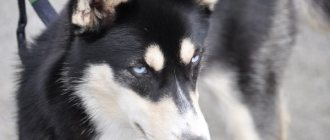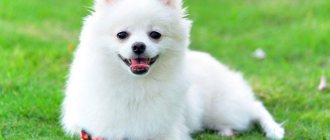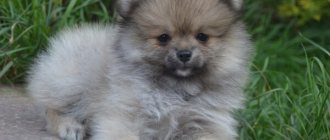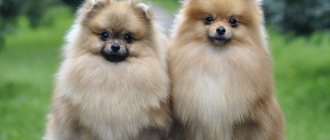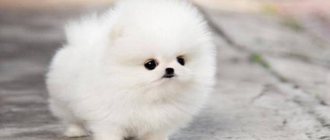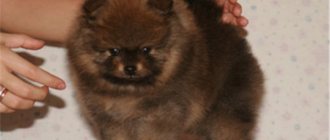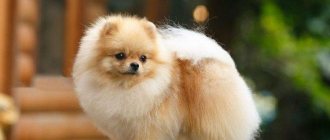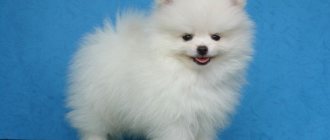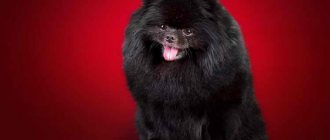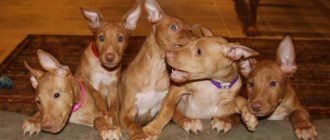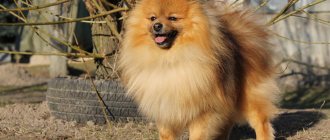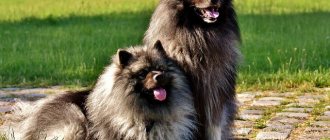Short description
Pomeranians are miniature decorative dogs that are distinguished by their good nature, positivity and attractive appearance .
Representatives of the breed are very active, obedient and loyal to their owner. They have a compact build, a small head and a well-shaped muzzle.
The dog has tight, dry lips, small teeth and a scissor bite.
The Pomeranian's ears are set high, erect, and have a triangular shape. Paws are straight and strong. The tail is of medium length, set high and curled over the back.
The calling card of the breed is its beautiful and lush coat, thanks to which the dogs have become so popular.
The main feature of Spitz wool is the vertical arrangement of the hair, which gives the hair volume and looks rich and elegant.
Dwarf Pomeranian Spitz
The Dwarf Pomeranian is a small, active and energetic dog, distinguished by intelligence, intelligence and playfulness.:
- Their body is square.
- The head is moderately convex, with a well-defined transition to a rather short, but not wide muzzle.
- The ears are small, erect, triangular in shape.
- The eyes are almond-shaped, dark brown. The look is lively, smart and friendly.
- The nose is black; in brown Spitz dogs it is brown.
- The neck is not too long, with a smooth transition to the withers. The back is flat, straight and rather short. The chest is of sufficient depth and volume. The belly is moderately adjusted.
- The forelimbs are level, straight and parallel. The hindquarters are moderately muscular and are pulled back somewhat when standing.
- The tail is in a ring or simply carried over the back in the form of a plume.
The wool is two-layer, consisting of a fairly strong, but at the same time elastic, outer coat and a very soft undercoat, which looks and feels like cotton wool.
The Dwarf Pomeranian should look compact, but not squat..
Origin story
The ancestor of modern Pomeranians is considered to be the common Spitz, bred back in the 15th century in Germany . Its height at the withers was 30-35 cm, and its weight reached 15 kg. Such dogs were engaged in shepherding and were faithful companions of German peasants.
Sometimes among the Spitz litter there were very small puppies that did not grow up and remained tiny for the rest of their lives. This gave impetus to the breeding of miniature representatives of the breed.
That is why in the 17th century the Spitz became the object of selection, and in the 19th century miniature dogs appeared in England . It was here that the Spitz acquired its modern appearance, thanks to British breeders.
Types of dogs
There are three types of dwarf Pomeranians, differing from each other in the structure of the head, muzzle, ears and coat length.
"Bearish"
Bear-type dwarf Pomeranians look like teddy bears, which is often emphasized by their haircut. Their head is round and wide, and their muzzle is slightly upturned and very short.
Some "bear" type Spitz have a muzzle length that does not exceed a centimeter . The nose is large, the eyes are quite close-set, very dark and expressive.
Long and thick hair on the animal’s cheekbones creates the illusion that the dog’s cheeks are round and plump.
Currently, it is the dwarf oranges of the “bear” type that are especially popular.
This is not always to the benefit of the breed, especially when you consider that in the pursuit of a more endearing appearance of such dogs, their health is often sacrificed for the sake of fashion.
"Fox"
Fox-type Dwarf Pomeranians are similar to the classic German Spitz. With the shape of their head and rather long, narrow muzzle, they resemble small fluffy foxes.
Like other Pomeranians, they have a square body, but their paws and tail are longer than those of other representatives of the breed . The fur of “fox cubs” is average in length and fluffiness.
"Toy"
Spitz "toys" belong to the intermediate type. Their muzzles are longer than those of bear cubs, but shorter than those of foxes.
They got their name due to the fact that their eyes are quite widely spaced and set higher than those of “bear cubs”, which gives them a special, “doll-like” expression of the muzzle.
Character traits
Pomeranians are active, cheerful and kind dogs that do not even have a hint of aggression..
As a rule, they love children very much and are attached to their owner and family members. A distinctive feature is a ringing and loud bark, thanks to which the dog can be an excellent watchman. But if the pet is not raised, then this can turn into a problem.
In addition, the dog is distinguished by self-confidence and even a certain impudence . But, with all this, the Pomeranian always tries to please the owner, and with proper upbringing, he is quite obedient.
The breed is distinguished by high intelligence and trainability . For 5 months the puppy has been able to carry out commands, tricks and requirements.
Expert opinion
Kozhevin Semyon Kirillovich
Expert dog handler.
“The main character traits of a Spitz include: cheerfulness, unpretentiousness and a constant desire to communicate. This dog is perfect for families with children 6-15 years old. But still, the dog needs a firm hand, since he is quite capable of sitting on his owner’s head. Cockiness, barking for no reason and disobedience can become characteristic features of a dog if it is not raised correctly.”
Breed varieties
A single standard has been developed for the breed, adopted by the FCI. Officially, there are no varieties of Pomeranian. In the same breed group and section along with the dwarf are the German, Kleine, Grossspitz, and Wolfspitz. All animals have different colors, heights and personalities.
In some countries, the standard Pomeranian is combined with the German or standard Spitz. The United States is trying to develop its own type of breed, called the bear breed. The American Dwarf Mini Spitz has a short upturned muzzle, large close-set eyes, and a rounded skull.
Such deformations may in the future lead to the development of genetic hereditary diseases associated with breathing and the visual apparatus. The bear type is already accepted for exhibitions, but European breeders reject such puppies.
Color and coat type
Wool is a real calling card. This type is typical for all Spitz dogs: smooth, hard guard hair (up to 7 cm) and a soft, thick, padded undercoat. In cold climates it hardly falls. The shortest pile is on the ears and muzzle and forehead. A collar forms on the neck, and a fountain forms on the tail.
Among the colors, black, red and white Spitz are common. Also found in apricot, gray, tan, cream, brown. The head is often darker than the collar and body.
White Spitz - character description
The character of the dwarf Spitz can be called “eternal holiday”. It seems as if these kids never get tired or lose heart. They are constantly on the move: running, barking, playing. They need to walk a lot and communicate, otherwise consequences cannot be avoided: torn shoes, scratched furniture, broken dishes. Mini Spitz will find their own entertainment.
Pomeranians are very inquisitive. They love to watch people and animals and often sit on the window. The breed is peaceful, non-conflict, and gets along well with other pets. But the small Pomeranian does not like children's pranks, so a small child should not have such a pet.
The breed is characterized by a sharp, inquisitive mind. Mini Pomeranians learn quickly, easily remember commands and are happy to carry them out in exchange for treats. But due to their high intelligence, mini Pomeranians often consider themselves the most important in the family, they are stubborn and try to manipulate.
Advantages and disadvantages
Like any other breed, the Pomeranian has both advantages and disadvantages.
The advantages include:
- Cheerful and cheerful character.
- Lack of aggression, attachment to the owner, love for children.
- Attractive appearance.
- Clean and odorless.
- High intelligence and learning ability.
- Obedience and adequacy.
- Relatively easy to care for.
- Good health.
Cons of the breed:
- Tendency to constant barking.
- The need for frequent brushing and careful grooming.
- Tendency to shedding and hair loss.
- Cockiness. In the absence of proper upbringing, Spitz dogs can bully even large dogs, which often ends in tragedy.
- Intolerance of loneliness. Being alone for a long time causes severe stress in the dog and can lead to mental disorders.
- Problems with teeth and bite.
Walks
The harmonious development of the Pomeranian Spitz is impossible without regular time spent in the fresh air. An active orange is cramped in an apartment, and even in a house - only on the street can it fulfill its needs for movement and feel freedom of movement. Sunlight, air, and frost in winter have a beneficial effect on the formation of a puppy and the maintenance of good shape of an adult Pomeranian.
During walks, which the Pomeranian Spitz loves so much, it’s good to play with him, in the game he can consolidate or instill obedience skills, and lay the foundations for training.
They walk the puppies often, as soon as their feeding and sleeping schedule allows. At first, these forays are short and short-lived, but as they grow older they become longer and longer, expanding the horizons of knowledge. During walks, the animal learns to react correctly to surrounding noise, strangers and animals, and to overcome difficulties.
Color variations, which colors are the most popular?
Pomeranian Spitz color options:
- White.
- Sable.
- Brown.
- Ginger.
- Blue.
- Cream.
- Zonal gray.
- Black and tan.
- Party color.
- Brindle.
- Spotted.
- Black.
The most popular colors are: red, cream, black and brown.
Separate breed or genetic marriage? What is the difference from the mini?
Dwarf Pomeranians are not allowed for exhibitions or breeding. And as adorable as they are, they should be considered a breed defect.
Dwarf Pomeranians are even smaller than the mini variety of this breed, weighing on average 1.7-1.9 kg .
What types are there?
Based on appearance, we can distinguish 3 types of oranges:
- Fox type. Its representatives have an elongated muzzle, almond-shaped eyes, sharp erect ears, thin paws and a lush “raven”.
- Bear type - characterized by a short flattened muzzle, sweaty paws, lush fur and round eyes.
- Mini Spitz - has features inherent in both the fox and bear type, but is distinguished by its miniature size (maximum height at the withers - no more than 22 cm).
- Dwarf.
Dossier
Height of an adult dog: 18-22 cm. Weight: up to 4 kg. Characteristic color: white. Coat length: longhaired. Life expectancy: up to 16 years. Advantages of the breed: friendly, loyal, easy to train. Difficulties of the breed : talkative, brave beyond size. Average price: 100-1000 dollars. Classification: small, decorative, companion.
Nutritional features - how to feed correctly?
In order for a dog’s body to function normally, its food must contain proteins, carbohydrates, fats, vitamins and microelements.
Moreover, all this must be in a certain proportion; only such food can be considered balanced.
Therefore, a dog’s diet must contain :
- Lean meat (raw or scalded).
- Stewed or fresh vegetables (carrots, cabbage, beets, pumpkin, zucchini, cucumber).
- Fruits (bananas, apples, melon).
- Offal (beef, heart, liver, tripe, lung or udder).
- Boiled low-fat sea fish.
- Porridge.
- Boiled eggs.
- Fermented milk products (yogurt, yoghurt, kefir, cottage cheese).
NOTE!
The Pomeranian's diet should consist of 2/3 protein foods (meat, offal, cottage cheese, fish, etc.) and 1/3 vegetables, fruits and cereals.
The dog should absolutely not be given:
- Chocolate.
- I'll bake it.
- Pork.
- Smoked meats and sausages.
- Salty and spicy foods.
- Milk.
If you feed your dog dry food, you should know that good food always contains meat, fish, liver and vitamins A and B.
An adult dog is fed 2 times a day, and it should have access to clean water around the clock.
Feeding and diet
In the first two weeks after purchasing a pet, the puppy should be fed in accordance with the breeder's recommendations..
Only after the process of adapting the baby to the new home is completed, it will be possible to transfer him to the feeding option that is most suitable for the owner.
Due to the small size of the dwarf orange, it can be difficult to calculate the correct ratio of foods in its diet.
Therefore, most breeders and owners feed their dogs a ready-made complete super-premium or holistic food.
When feeding naturally, at least a third of the diet should consist of animal protein products: meat or offal. To them you need to add a little porridge, as well as cottage cheese, kefir or natural yogurt.
A dog’s diet cannot do without vegetables, which are fed to the Spitz both raw and cooked.
The number of feedings depends on the age of the pet: at first, while the puppy is small, he is fed 4-5 times, but by the age of one year he is gradually transferred to twice feeding.
Health and major diseases, life expectancy
The life expectancy of an orange is 12-16 years.
Major diseases:
- Periodontal disease . The reason is that the jaw is too small, which often leads to crowded teeth and deformation of the dentition, as well as gum inflammation.
- Alopecia is hair loss. Most often found in older male dogs.
- Medial luxation of the patella is an inherited condition in which the patella protrudes out of the groove of the femur.
- Hypoglycemia is low blood sugar.
- Distichiasis is abnormal growth of eyelashes, leading to injury to the eyeball.
- Tracheal collapse is a narrowing of the tracheal lumen due to softening of the cartilaginous rings.
- Cataracts are an eye disease that is common in older dogs.
- Testicular tumor.
- Difficult birth.
Diseases of Pomeranian Spitz
Artificial breed dogs are prone to systemic diseases, i.e. those caused by improper functioning of the endocrine glands or the brain. Pomeranians are characterized by:
- Thyroid diseases. They manifest themselves as lethargy, even apathy, loss of appetite, dry skin, hair loss, even baldness in certain areas, and obesity. Lifelong therapy is prescribed by a veterinarian.
- Epilepsy. Occurs due to malfunctions in the brain. Characterized by attacks of clonic convulsions. They are treated with long courses of medications with a gradual reduction in dose.
- Kidney failure. The reason is the sensitivity of the Spitz genitourinary system to changes in living conditions (diet, regime, temperature, viral infection). The treatment is carried out by a doctor.
- Weakness of bones, ligaments and joints. It is detected at an early age (deformation) or manifests itself due to improper organization of leisure time. Pomeranian Spitz are strictly not recommended to jump even from a small height.
- Allergy. It can occur not only when the diet changes, but also when the consumption of a product that has long been familiar to the Spitz is exceeded. Treated with diet.
Caring for a pet means carefully observing and noticing the first signs of illness. Infectious and viral diseases in most cases occur in unvaccinated oranges and due to improper care of animals.
Vaccination calendar
The first vaccination of a Spitz is usually done in the kennel, before the puppy is handed over to the owner. This is a comprehensive vaccine against three dangerous diseases for dogs: distemper, enteritis and hepatitis. Carry out in 2 stages with an interval of three weeks and annual revaccination.
Further vaccination is the responsibility of the orange owner. Vaccinations are carried out on the recommendation of a veterinarian. They discuss with him the relevance of rabies, leptospirosis, parainfluenza, piroplasmosis and dermatomycosis to the area.
Two weeks before vaccination, the Pomeranian Spitz is subject to mandatory deworming. Otherwise, the effectiveness may be insufficient and the side effects may be excessive. It is unacceptable for an unvaccinated dog to participate in the breeding of pedigree puppies.
Before the first vaccination, the Pomeranian's social circle with other dogs is limited. Only healthy animals are vaccinated.
Education and training
Spitz dogs are distinguished not only by their high intelligence, but also by their obedience . Spitz dogs love to follow commands and receive praise, which is why raising a Pomeranian is quite easy.
However, with poor upbringing, a dog can have a rather bad character, bark incessantly, rush at passers-by and even at the owner. That is why it is necessary to engage in raising a dog from the first days of its appearance in the house.
The dog must know its place, respond to its name, not show aggression and not bark for no reason..
In addition, you need to train your dog to toilet as early as possible (first in the litter box, and then outside).
Separately, it is worth mentioning the prohibitions.
Under no circumstances should the dog:
- Sleep with the owner.
- Steal from the table.
- Show aggression towards other animals and people.
- Beg for a treat.
- Ignore commands and demands.
- Relieve your natural needs anywhere.
The dog must know such commands as:
- "Place".
- "To me".
- "Sit".
- "Near".
- "Ugh".
Puppy at home: how to properly organize his life
By the time a small dog appears in the family, all household members should be prepared. Caring for a Pomeranian puppy and keeping an adult Spitz are not entirely identical.
The puppy requires a lot of attention. It is communication with a person that makes it easier for him to get used to changed conditions, learn new skills, maintain health, and therefore avoid difficulties in adult life.
For the first time, before vaccination, it is advisable to care for your pet, limiting contact with other animals and people.
Features of care
Despite their attractiveness, Spitz dogs are very picky in their care.
However, there are several rules that must be followed to ensure that the dog is always healthy and beautiful.:
- Grooming. Your pet's coat should be brushed 1-2 times a week. For this purpose, special combs are used. During shedding, the dog is brushed daily, removing the old undercoat. The Spitz is bathed once every 1-2 months using special shampoos and conditioners. As for cutting, it is done as the fur grows back.
- The dog needs weekly ear cleaning. This is done using a cotton pad and a special lotion.
- Approximately once every 2 weeks, pets’ nails are trimmed using a special nail clipper and nail file.
- Once a week, the dog’s teeth are brushed with a special brush and toothpaste intended for dogs.
- Daily walks are an integral part of proper care for your Pomeranian, as it needs physical activity. Walk the dog at least 2 times a day.
- The dog must receive all necessary vaccinations according to the schedule.
- Approximately once every six months, the pet should be shown to the veterinarian for preventive purposes.
- Once every 3 months the baby is given anthelmintic drugs.
- Your dog should be treated for fleas and ticks monthly.
Coat color
The bear-type Pomeranian has many variations in coat color. The most common shade of this dwarf breed is red or fiery red. There are also black, white, brown, beige and many other colors.
The breeders agreed that the hardest thing to get is a white and a black “bear cub.” By crossing dwarf Spitz dogs of the same shade, it is difficult to obtain the same color. With luck, the dog may not always be small, and the quality of the coat may deteriorate.
You can find out exactly what color the dog will be only closer to a year, since it is impossible to determine at birth.
How to choose?
Before purchasing a Pomeranian puppy, you need to familiarize yourself with the breed standards, so it will be easier for you to navigate.
The second important point is to buy a dog only from a kennel, and not from a flea market. Moreover, the meeting with the breeder should take place directly on the territory of the nursery.
While in the kennel, pay attention to the conditions in which the dogs live, what they are fed and how they look.
Particular attention should be paid to the mother of the babies. But you should be prepared for the fact that the Spitz bitch after giving birth looks very unattractive, she is tired and almost bald. But don’t be afraid, after 5-6 months the dog will return to its previous appearance.
IMPORTANT!
When choosing, you should ask about the father of the babies; if he is not in the nursery, then the breeder should have his photograph and copies of documents.
When buying a puppy, pay attention to the price; too low a price should be a concern. A good puppy simply cannot be cheap.
A very important aspect is the examination of the baby himself.
What to look for:
- The pet's ears and eyes should be clean and free of discharge.
- A healthy puppy's coat is shiny, not ruffled, and without bald spots.
- Under no circumstances should the baby’s belly be swollen or sunken, and there should also be no umbilical or inguinal hernias.
- The puppy's skin should be clean, free from wounds, abrasions, rashes and dandruff.
- The baby should not smell unpleasant.
- Particular attention should be paid to the teeth. The puppy should have 6 incisors on the upper and lower jaws, as well as 4 canines.
- A healthy baby’s nose is moist, without discharge or dry crusts.
- It is also worth observing your pet's movements. In a healthy puppy they are free and confident.
Before sale, the puppy must be dewormed and vaccinated, and also have a brand and documents.
When choosing a puppy, you should not stop at one nursery, look at several and compare them with each other.
Training
It is necessary to raise a White Pomeranian Spitz from the very first days. Be sure to provide your baby with care and attention so that he trusts you and feels safe. Start training immediately. Show that you are in charge . After all, white Spitz love to take the position of leader. Conduct training every day. Keep them entertaining and short.
After each correctly completed task, praise your pet and treat it with a tasty treat. Thanks to your patience and the efforts of your Spitz, you will be able to raise him. You can contact a professional trainer and teach your child not only tasks, but also acrobatic tricks.
Characteristics of the breed and brief historical background
An adult specimen of those times reached a weight of 15 kilograms and because of this did not quite correspond to the status of a pet. Representatives of the nobility instructed specialists to carry out breeding work and reduced the size of the Pomeranians, while maintaining their attractive appearance and thick fur.
The work in this direction was a success and the result was small and cute dogs. It is worth noting that in the end the dog was reduced in size almost threefold.
Towards the end of the 19th century, the Spitz dog became an individual variety. The new group included animals of such colors as: cream, black, peach and red. It was also possible to meet dogs whose color consisted of three colors.
The White Pomeranian became a separate species that was bred in the United States of America. It is worth noting that white Pomeranians are the most expensive.
Scientists say that the miniature Pomeranian Spitz appeared thanks to the Queen of Great Britain - Victoria. She loved dogs very much and actively promoted love for animals.The Queen brought from abroad and delivered to England the first Spitz, whose weight was less than 5 kilograms.
How to teach your Spitz commands yourself
Even beginners can train a Pomeranian at home. This is a smart dog, he remembers orders and tricks on the fly. You can teach commands yourself, the main thing is not to be fooled by provocations.
"Ugh" and "No"
You need to teach your Spitz the prohibition commands first. In a critical situation, they will save the fluffy's life.
There are 2 ban commands. They are considered the same, but the orders have different purposes:
- "Ugh". It means a categorical prohibition on an action that is performed here and now. They say it in a stern, intimidating voice.
- "It is forbidden". It prohibits something in the long term: climbing on the bed, carrying food, rummaging in the trash, following strangers. The order is also given strictly, but without threatening notes.
Spitz training for the “Fu” and “No” commands is the same. There are 3 ways:
- hold a treat in your fist, bring it to the German Spitz’s nose, command “Fu” or “No” when the dog stops reaching for the treat, encourage him;
- they do the same thing, only the treat or toy is not clutched in the fist, but placed not far from the student;
- if the pet does something inappropriate during a walk, the leash is sharply pulled back and “Ugh” is said.
The fidget prohibition command must be carried out immediately, always and everywhere.
"Give"
Skill training is carried out during games. When the puppy approaches the owner with a toy in his teeth, he fixes it with his fingers, says “Give” and carefully removes the object from his mouth. The thing is not pulled - the action is perceived by the dogs as an invitation to measure their strength.
"To me"
There is no more important command than “Come to me.” You need to teach your Spitz this order in the first weeks of life and practice the skill until it becomes automatic.
Training a Spitz to the “Come to me” command is simple, it is carried out like this:
- hold a treat in your hand and walk away a short distance;
- show a treat and pronounce an order;
- as soon as the dog approaches, it is encouraged;
- You can combine the order with pulling on the leash.
It is forbidden to scold the dog after carrying out the order “Come to me”. Even if he had previously “chewed” the neighbor’s cat, when the pet came up on command, he was only praised. Otherwise, your pet will develop negative associations and will not obey.
"Place"
Skill training is carried out immediately after the puppy appears in the house. The kitten is picked up and carried to his bed, saying the command “Place.” If the dog remains on the bedding, he is praised and treated. If it follows the owner, it is returned back.
A dog's place is sacred territory. Here you cannot scold the dog, forcefully pull it off the bedding, squeeze it, etc. German Spitz quickly understand this. Having played a prank, they rush headlong to the bed, avoiding being thrashed.
"Voice"
Spitz barks by nature, and teaching them the “Voice” command is easy. For this:
- hold a treat in your hand and tease the dog;
- raise your hand up without giving away the tasty treat;
- command “Voice” - the dog immediately barks, not understanding why it is not being given a treat.
Teaching the “Voice” command will help control the excessive talkativeness of Germans and teach them to bark only when ordered.
"Quiet"
The “Quiet” command is taught in tandem with the “Voice” order. For this:
- the pet is provoked to bark with a treat - as soon as he barks, they order “Voice”;
- they command “Quiet” and squeeze their mouth with their hand - if the dog continues to bark or struggle, the treat is not given;
- The pet is rewarded for correct behavior.
It is important to train the skill in involuntary situations. As soon as a German Spitz barks without a reason, they clamp his mouth and command “Quiet.”
"Sit"
The skill of endurance along with “Lie down”, “Stand”, “Wait”, “Place”. The “Sit” command is taught first, only then they move on to other orders for patience.
Training is carried out in 2 ways:
- they bring a treat over their head and take it back - reaching for the treat, the fluffy sits down, at which time they are ordered to “Sit”;
- command “Sit” and press on the pet’s croup.
"Lie"
They move on to the “Lie down” command after the “Sit” skill has been mastered. For training:
- make the dog sit;
- bring your hand with the treat to your nose, lower it down and at the same time move it back;
- the dog will reach for a treat and lie down - immediately order “Lie down”, reward the dog with praise and treats;
- if the pet does not lie down, press on the withers.
"Stand"
Teaching a Spitz this skill is difficult. Dogs are as mobile as mercury; it is difficult for them to remain in one place for a long time. But skill is needed. For this:
- put the dog next to your leg;
- say “Stand” and lift the pet under the belly;
- hold it for 5-10 seconds, encouraging it with your voice;
- praise and treats.
When the skill is practiced from a static position, they move on to walking training:
- stop abruptly in motion;
- lightly slap the dog’s chest and command “Stop”;
- stand for 5-10 seconds.
Then they connect the endurance skill. When a command is given, the dog must remain in place until the owner allows him to move on. To do this, after the order, they leave the pet and wait a few minutes. Gradually the distance and time increase.
"Near"
On command, the Spitz should calmly walk at the owner’s feet, 1/3 or half of the body behind the person. This is achieved like this:
- place the pet at the foot - right or left;
- hold a treat in one hand and a leash in the other at a distance of 0.5-1 m from the dog;
- show a treat, say “Nearby” and start moving;
- The Pomeranian is rewarded every few steps, gradually lengthening the time between snacks.
As you master the skill, the exercise becomes more difficult. They move at different paces, turn around, stop abruptly.
"Give me your paw"
Giving a paw is an optional skill. But people like this skill performed by adorable German Spitz dogs.
The command “Give me your paw” is taught like this:
- they hold their paw in their hand, giving an order;
- after a few seconds they praise and treat the pet;
- Afterwards they say “Give me the other paw”, change hands and raise the desired limb.
Spitz dogs learn to give paws in 2-3 days. Difficulties arise only with their change.
"Aport"
The “Fetch” skill is first practiced during the game. When a puppy runs up to its owner with a toy or stick in its mouth, they give an order and praise the baby.
They begin full-time training at 6-7 months, when the junior has perfectly mastered the skills “Sit”, “Come to me”, “Give”. For this:
- fasten a long leash to the collar - 3-4 meters;
- sit the German Spitz near the leg;
- take a stick or toy, tease the dog and throw it a short distance;
- they say “Fetch”, wait until the dog approaches the object and takes it in its mouth;
- pull the leash or say “Come to me” - this way the pet will understand that it needs to return;
- They take the item using the “Give” order and exchange it for a treat.
"Bow"
Another optional but nice skill. The “Bow” command is taught like this:
- lower the treat to the ground as when practicing the “Lie Down” skill;
- as soon as the German Spitz begins to lie down, put your hand under the lower abdomen and lift the croup;
- in the end, the dog should remain with its front legs extended and raised, occupied - as if stretching;
- They say “Bow” and encourage.
Basic colors
- Black. It should be pure black, without interspersed with hairs of a different color. No white markings, even the smallest ones, are allowed in this color.
- Black and Tan . On the main black background there are reddish or fawn markings. Spitz have tan on the inside of the ears, above the eyes, on the muzzle, chin and neck, as well as on the chest, on the paws and under the tail.
- White. With this color, the coat color should be dazzling white, without signs of yellowness.
- Soboliny . The guard hair is zoned gray, and the undercoat can be gray, cream or red.
- Brown . Single color and, if possible, the most uniform color in various shades of brown or chocolate.
- Ginger . This color can be described as bright, golden fawn or peach. It can vary in saturation and brightness of shades, and sometimes there is a lightening of the fur on the “collar”, “pants” and “tail”.
- Blue . In fact, it would be more correct to call this color gray. It comes in different intensities and lightness: from silver-steel to lead or graphite.
- Cream . It can be very light - almost white, or pale reddish or golden.
- Zonal gray . Mini Pomeranian Spitz of this color looks like a wolf cub. He has blackened fur on his ears, around his eyes, on his eyebrows, and on the tip of his tail. But the undercoat and fringes on the lower part of the tail and on the collar, on the contrary, lighten to a light gray shade.
- Two-color . On the main white background there are small spots of red, brown or black colors.
The currently popular merle color is not recognized as a standard and is regarded as a breeding defect.
